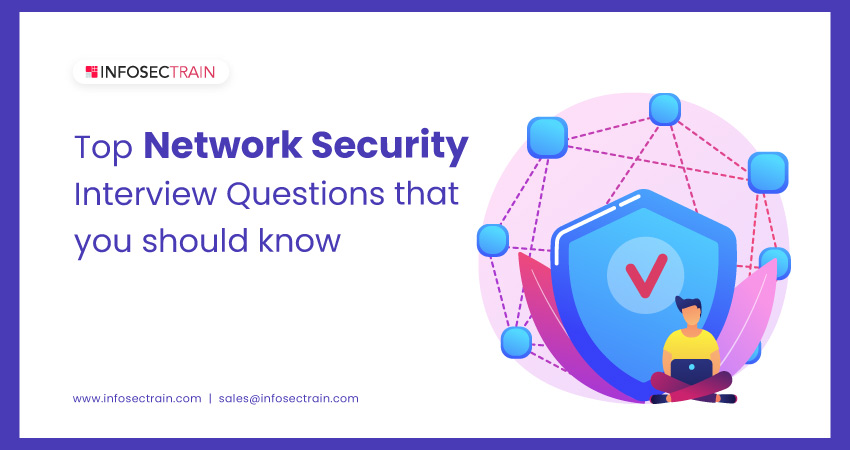Top Network Security Interview Questions That You Should Know
As the world becomes more reliant on the internet and the World Wide Web, network security is becoming an increasingly important concern for organizations of all sizes to consider and plan for. Due to the over-reliance on various verticals for business and personal communication, network security is one of the essential parts of any information security process. To ensure optimum digital security and compliance, organizations of all sizes and scales should have proper strategies and mitigation processes in place to secure their networks. In this article, we will discuss the most frequently asked questions in a network security interview.

Question 1: What is the goal of network security in a company or organization, in your opinion?
Answer: Network security should include the following components:
- Ensure that all users have access to the network at all times
- Prevent unauthorized access to your network
- Maintain the privacy of all clients
- Protect networks from malware, hackers, and Distributed Denial-of-Service (DDoS) attacks
- Protect and secure all data from theft and corruption
Question 2: Define vulnerability, threat, and risk in the context of network security?
Answer: Vulnerability: A vulnerability is defined as a flaw or violation in your system or hardware like modems, routers, access points.
Threat: A threat is a method by which an incident is caused; for example, a virus attack is considered a threat.
Risk: A risk is an increase in the likelihood of a threat resulting from a secure but not sufficiently protected system.
Question 3: What are the possible consequences of a computer network attack?
Answer: The following are examples of potential outcomes:
- Data that is critical to a company’s survival and success is lost or corrupted
- Shareholder’s value has dropped
- Profit lowered
- Customer’s trust and reputation have deteriorated
- Decrease brand value
Question 4: What are the best ways to protect yourself from a brute force login attack?
Answer: You can take three significant steps to defend against a brute force login attack.
- There is a lockout on your account. Infringing accounts are disabled until the executive chooses to reactivate them.
- The progressive delay defense comes next. After a few unsuccessful login attempts, the account is locked for a specified number of days.
- At last, the challenge-response check prevents the login page’s automatic submissions.
Question 5: Define the terms symmetric and asymmetric encryption.
Answer: Symmetric Encryption: The same key is used for both encryption and decryption in symmetric encryption. When it comes to symmetric, the process moves at a faster rate.
Asymmetric Encryption: Different keys are used for the two processes in asymmetric encryption. This method of encryption is difficult and time-consuming.
Question 6: Define the terms white hat and black hat hacker.
Answer: White hat and Black hat hackers are two synonymous terms. Both groups are knowledgeable at breaking into networks and gaining access to otherwise secured data.
White Hat Hacker: These are referred to as ethical hackers. Organizations or government agencies commonly use them to identify flaws.
Black Hat Hacker: The creation of malware is the responsibility of Black hat hackers. They gain unauthorized access to data or networks, causing severe damage and stealing sensitive information.
Question 7: Define the salting process and its application.
Answer: Salting adds special characters to a password to make it more secure. This strengthens the passcodes in two ways: it makes it longer and helps to add another set of characters from which a hacker would have to guess. It’s a reasonable precaution to take for users who have a habit of creating weak passwords. Still, it’s a low-level defense because many highly experienced hackers are already familiar with the process and consider it.
Question 8: What are your strategies for dealing with “Man-In-The-Middle” attacks?
Answer: A Man-in-the-Middle attack occurs when a third party monitors and controls communication between the two parties while the latter is utterly unaware of the situation. There are two approaches to dealing with this attack.
- Stay away from open Wi-Fi networks
- Both parties should use end-to-end encryption
Question 9: Which is the more secure option, HTTPS or SSL?
Answer: HTTPS (Hypertext Transfer Protocol Secure) combines HTTP and SSL (Secure Sockets Layer) to encrypt and secure a user’s browsing activity. SSL (Secure Sockets Layer) is a data encryption protocol that encrypts data sent over the internet among two or more entities. Though this is close, SSL comes out on top in terms of overall security, though any of these are useful to know for web development.
Question 10: What does AAA stand for?
Answer: AAA is an acronym for Authentication, Authorization, and Accounting.
Authentication: The procedure of determining whether a user is authorized to use the system and network is known as authentication. Login and password are commonly used for authentication.
Authorization: Access control rights are referred to as authorization. This means that, depending on the position in the organization, each user on the network has access to different portions of data, information, and applications.
Accounting: Network accounting is a type of accounting that collects all network activity for each user.
Question 11: What exactly is the CIA triad?
Answer: Confidentiality, Integrity, and Availability are abbreviations for CIA. The CIA model is intended to guide information security policies in organizations.
Confidentiality: Confidentiality is another term for privacy. Implementing access restriction mechanisms ensures confidentiality. Confidentiality can be defined as protecting a user’s privacy within a system.
Integrity: The term integrity refers to the stability, precision, and trustworthiness of data throughout its entire lifecycle.
Availability: The term “availability” defines the availability of the entire network’s assets and infrastructure components to authorized users.
Question 12: What exactly is IPS?
Answer: An Intrusion Prevention System (IPS) is a threat prevention technology that examines all network data flow to detect and prevent malicious activity and network vulnerabilities. It is helpful because it can be designed to identify various network types of threats and potential weaknesses.
Question 13: What exactly is a social engineering attack?
Answer: Social engineering is a term that refers to attacks that can be extremely hard and dangerous for a hacker to carry out. It is primarily based on human engagement, which entails accumulating personal information through purely illegal inclusion and easily manipulating and exploiting their data for personal gain.
Question 14: Explain traceroute.
Answer: It’s a program that displays the packet path. It contains a list of all the points through which the packet passes. The traceroute command is used when a packet fails to reach its destination. Traceroute is used to determine where the links break or halt and pinpoint the breakdown source.
Question 15: Make a distinction between HIDS (Host Intrusion Detection Systems) and NIDS (Network Intrusion Detection Systems)?
Answer:
| HIDS (Host Intrusion Detection Systems) | NIDS (Network Intrusion Detection Systems) |
|
|
|
|
Question 16: What exactly is port scanning?
Answer: Port scanning is a method for identifying open ports and services on a particular host. It is a technique used by hackers to find sensitive data.
Question 17: How do I reset a BIOS configuration that has been password-protected?
Answer: There are several methods for resetting the BIOS password. Here are a few examples:
- Take out the CMOS battery
- By making use of the software
- By making use of a motherboard jumper
- By employing MS-DOS
Question 18: Describe ARP and its operation.
Answer: It’s a protocol for determining the MAC address of an IPv4 address. This protocol serves as a link between the OSI network layer and the OSI link layer.
Question 19: Define the term “exfiltration.”
Answer: The unauthorized transfer of data from a computer system is known as data exfiltration. This transmission could be done manually by anyone with physical computer access.
Question 20: Explain what cross-site scripting is.
Answer: Malicious scripts are injected into websites through a network security vulnerability known as cross-site scripting. When intruders allow an unreliable element to infuse syntax into a web application, this is known as a cross-site scripting attack.
Network Security with InfosecTrain
Whether you are trying to break into the field of network security or just want to brush up on your skills, training and instruction are essential. It’s even better if you add certification courses to your knowledge base. The network security certification course by InfosecTrain gives you an advantage by demonstrating to potential employers that you know about network security.




 1800-843-7890 (IN)
1800-843-7890 (IN) sales@infosectrain.com
sales@infosectrain.com
 1800-843-7890 (India)
1800-843-7890 (India) 
